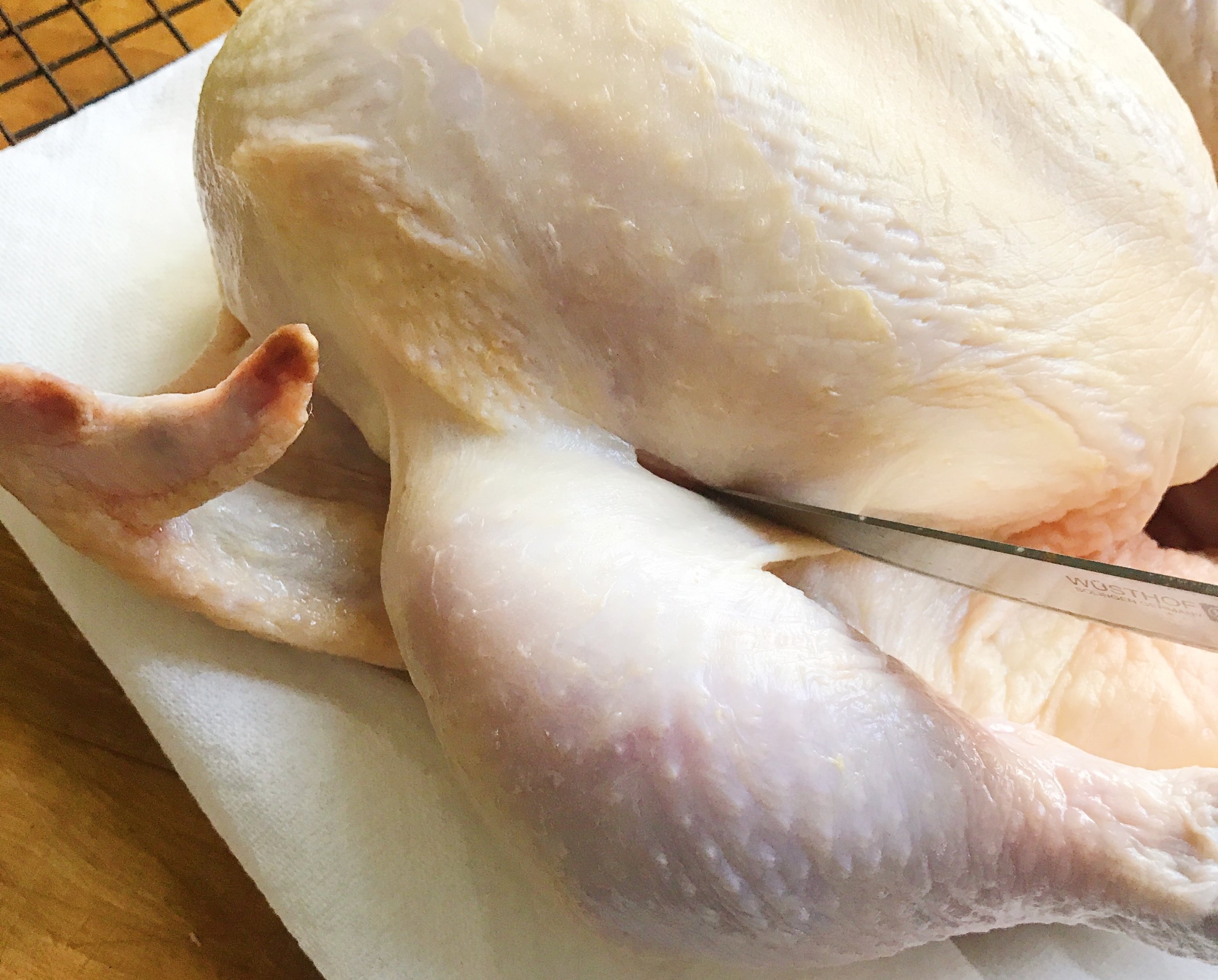tips & tricks: roasted whole chicken
stop right now! stop thinking that a whole roasted chicken must be super hard and intimidating. roasting a whole chicken requires about 20 minutes of prep and is worth EVERY SECOND. there is NOTHING like making your own whole chicken to either feed a family of five or to last you for multiple meals. not only that, you can use all the leftovers to make the most delicious home made chicken stock.
i promise you, making your own roast chicken is a GAME changer.
and since i want to make this really EASY and approachable for those, non believers, i’m going to break this down for you in three parts.
roasting the chicken. carving the chicken. making the stock.
so grab that chicken, and here we go!
roasted whole chicken
serves: 6-8
prep time: 20 minutes
roast time: 1 hour 30 minutes
inactive time: 20 minutes
ingredients. 5-6 lb whole chicken (remove any giblets that might be in the cavity). 2 cups chicken stock. .25 cup garlic herb butter. 1 brown onion, halved and sliced. 2 lbs yukon gold potatoes, cut into 1 inch cubes. 1 lemon, sliced. half an orange, sliced. 10 garlic cloves, smashed. 10 sprigs of thyme. 1 tbs kosher salt. 1 tsp freshly ground pepper. butchers twine. baking sheet + roasting rack. aluminum foil. meat thermometer (optional).
start by preheating your oven to 425 degrees f. pat your chicken dry with paper towels, even the inner cavity. season the inside cavity and the skin with three fourths of the salt and pepper. use a sharp knife to make some slices in the fattiest parts of the chicken skin so that the fat can render there and the skin can become nice and crispy.
then, rub your chicken down all over with the butter and slide some bits under the skin and in those little slits you made for the fat to render. stuff the cavity with a few slices of onion, the garlic, thyme, lemon and orange.
use the butchers twine to tie up the legs of the chicken so that all that goodness stays in the cavity.
line your baking sheet with aluminum. place your potatoes and onions on the baking sheet and season with the rest of the salt and pepper. spread it out in an even layer.
place your chicken on a rack over the potato and the onions, breast side up. roast the chicken for about 1 hour and 30 minutes. every 30 minutes, check on your chicken and baste it with about 1 cup of stock. focus on pouring it over the breasts to cool them down. they are bearing the brunt of the heat and they are done at a lower temperature than the darker parts of the meat.
after about 1 hour and 15 minutes, check the internal temperature of your meat with a meat thermometer. once the thickest part of the thigh has reached 165 degrees f, your chicken is cooked. HOWEVER. once you remove your chicken from the oven, the temperature will actually continue to rise and cook the chicken for the first 5-10 minutes out of the oven. so once you get between 160-163, you should be good. if you do not have a meat thermometer, you can check for doneness by slicing into your meat and seeing if the juices that run out are clear. if the juices are clear, your chicken is good to go. once your remove your chicken from the oven, lightly tent it with aluminum foil. you want to keep it warm while it rests, but you don’t want the skin to get soggy. allow the chicken to rests for 15-20 minutes before slicing so the juices can reabsorb back into the meat.
xo, a
roasted whole chicken
serves: 6-8
prep time: 20 minutes
roast time: 1 hour 30 minutes
inactive time: 20 minutes
ingredients. 5-6 lb whole chicken (remove any giblets that might be in the cavity). 2 cups chicken stock. .25 cup garlic herb butter. 1 brown onion, halved and sliced. 2 lbs yukon gold potatoes, cut into 1 inch cubes. 1 lemon, sliced. half an orange, sliced. 10 garlic cloves, smashed. 10 sprigs of thyme. 1 tbs kosher salt. 1 tsp freshly ground pepper. butchers twine. baking sheet + roasting rack. aluminum foil. meat thermometer (optional).
start by preheating your oven to 425 degrees f. pat your chicken dry with paper towels, even the inner cavity. season the inside cavity and the skin with three fourths of the salt and pepper. use a sharp knife to make some slices in the fattiest parts of the chicken skin so that the fat can render there and the skin can become nice and crispy. then, rub your chicken down all over with the butter and slide some bits under the skin and in those little slits you made for the fat to render. stuff the cavity with a few slices of onion, the garlic, thyme, lemon and orange. use the butchers twine to tie up the legs of the chicken so that all that goodness stays in the cavity. line your baking sheet with aluminum. place your potatoes and onions on the baking sheet and season with the rest of the salt and pepper. spread it out in an even layer. place your chicken on a rack over the potato and the onions, breast side up. roast the chicken for about 1 hour and 30 minutes. every 30 minutes, check on your chicken and baste it with about 1 cup of stock. focus on pouring it over the breasts to cool them down. they are bearing the brunt of the heat and they are done at a lower temperature than the darker parts of the meat. after about 1 hour and 15 minutes, check the internal temperature of your meat with a meat thermometer. once the thickest part of the thigh has reached 165 degrees f, your chicken is cooked. HOWEVER. once you remove your chicken from the oven, the temperature will actually continue to rise and cook the chicken for the first 5-10 minutes out of the oven. so once you get between 160-163, you should be good. if you do not have a meat thermometer, you can check for doneness by slicing into your meat and seeing if the juices that run out are clear. if the juices are clear, your chicken is good to go. once your remove your chicken from the oven, lightly tent it with aluminum foil. you want to keep it warm while it rests, but you don’t want the skin to get soggy. allow the chicken to rests for 15-20 minutes before slicing so the juices can reabsorb back into the meat.







